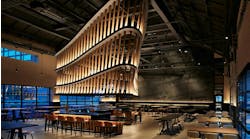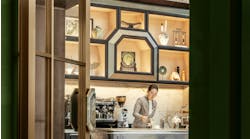Interiors today are blurry places. The lines that once distinguished between home, office and hotel are virtually nonexistent. As people increasingly spend their time working wherever it best suits them (because of mobile technology), the design of the workplace is starting to look and feel a lot more like home or a favorite destination hotel.
The kitchen island, for example, has inspired communal cafes in offices, and touchdown lounge areas that are reminiscent of living rooms or hotel lobbies encourage people to work away from their desks, assuming they even have a desk assigned to them. Even the idea that someone could take a nap in the office to recharge is a nod to the bedroom back home.
In other words, the influence of residential and hospitality design elements in the workplace are unmistakable, and the result is a sort of hybrid space that blends the best of all three worlds.
To be sure, as much as 33% of commercial projects completed since 2017 reflect a residential or hospitality feel, according to a study conducted by Contract Consulting Group (CCG), a research-led strategy firm that serves the contract interiors market, in partnership with National Office Furniture.
While the figure may appear somewhat low, it suggests one out of every three new office spaces is distinctly more casual than before. Notably, 86% of respondents to the survey agreed that corporate environments as a whole are evolving to embrace a more residential and hospitality influenced look and feel.
While the design industry has embraced our intermingled approach to life, it seems to be at a loss for what to call it. We throw around terms like “resimercial” (which surveys show designers don’t like) and more recently, “respitality” and “sophisticozy” or simply “casual comfort” in an attempt to define the shift in the way we design the places we inhabit.
But what exactly do these terms mean anyway, and what do they say about the current state of design and where it’s headed?
Making Shifts in Both Directions
Conry points out that companies aren’t looking to recreate a residence at work, per se, but rather they are asking designers to help forge “a strong connection in terms of purpose and identity that resonates with people in these other really important places in their lives.”
(Photo: McCANN; Photographer Jason Keen; Courtesy of Gensler)
The crossover between markets isn’t necessarily new, however, though it may be more prominent than before. Giana DiLeonardo, partner at hospitality design firm DiLeonardo International, suggests hospitality and residential design have always shared significant overlap in the design sector.
“This trend was most noticeable in the late ’90s and early 2000s with the rise of boutique properties and lifestyle brands,” she explains. “Guests wanted to experience a sense of place and a sense of comfort. The next logical step, as technology has allowed our workforce to become more mobile and move away from the traditional work environment, was the crossover from residential/hospitality to commercial.”
The influences go both ways as well, Conry says. She notes the workplace is becoming a richer experience because it’s taking cues from hospitality environments in terms of how to best execute things like amenities.
Conversely, hospitality is learning that as people live more seamless lives in terms of ”live-work-play,” they are looking for that multi-functionality wherever they go.
“Hospitality is taking cues from the workplace and how they can make their settings more conducive to letting people do what they need to do on their terms,” Conry notes.
Community and Choice Are Key Drivers
The technology and share economy sectors have been at the forefront of the drive and appeal for these kinds of spaces, according to DiLeonardo.
“Campus facilities that prioritize communal spaces such as kitchens and living rooms, are attractive to workers looking for a new, more collaborative work environment,” she says. “Today, armed with a laptop or tablet, meeting over a cup of coffee in the kitchen, or sneaking away to a private nook out of the open office environment for some focused time, have become the new modes of work in workplace design.”
Conry says the move toward providing more communal spaces in the workplace is ultimately about providing employees with more choices to find the appropriate space to do the type of work they need to accomplish.
The goal is not to provide a café, coffee shop or lounge as a place to give people a break from work, per se; rather, it’s giving them a space to take a break from the way they’re working in a different type of setting that might involve a food and beverage or communal experience, she points out.
[Related: Hotel Design Tactics Continue to Pop Up in Corporate Settings]
“I think at its core, it’s about giving people those places to come together in the ways that they find the most satisfaction and drive outcomes for the business,” Conry says. “Another part of it that is really important as a driver is striking the right balance between giving people some ownership and control over their spaces and finding the right degree of privacy when they need it, and then allowing them places where they can engage everyone and benefit from the energy that comes with some of those more collaborative and communal spaces.”
Moving seamlessly between public and private spaces is at the core of the hospitality experience, Conry points out. In a hotel, for example, guests can easily retreat to the privacy of their room when they need quiet or meet with co-workers or friends in the lobby or restaurant when they want to socialize or meet in larger groups.
She says to the extent that the workplace can offer similar experiences and choices, it will ultimately help employees function at their full potential to the benefit of the business.
Updating Office Design
According to National Office Furniture, the “respitality” trend signals the migration of the home-style design aesthetic to the modern work environment, the intent of which is to make the office feel less “office-like.”
These pieces reveal a little hint of utility, the arrangements of which resemble a well-appointed hotel room or home living room rather than an office.
(Photo: MarxModa; Photographer John Angelo; Courtesy of Gensler)
But effective design strategies go well beyond choosing the appropriate aesthetics. Both DiLeonardo and Conry suggest that hospitality design is more concerned with flow and understanding a guest’s journey through a space.
“Creating moments of activity, whimsy and respite are all part of the hospitality designer‘s playbook, and those strategies translate well into a corporate environment,” DiLeonardo notes. “Supporting the workflow and daily routine, as well as wellness and morale, can all be mirrored in the built environment.”
Conry agrees and points out that the hospitality industry is laser-focused on who the guest is and what their experience with the hotel brands is like from their first to last points of contact.
Hotels consider everything from a customer’s very first moment of engagement while booking their stay to their arrival at the property; their guestroom experience to the sense of wellness they feel; the food and beverage and social environments; all the way to their departure from the property. She believes workplace design should be considered just as carefully.
“I think it’s no different in the workplace setting, where we need think through the touchpoints and ask, ‘Who is this for?’” Conry says.
Whether it’s employees, clients or other stakeholders, companies need to think through how people arrive, how and where they work, how they interact and the choices they have to engage in different types of settings that enable them to do their jobs day-in and day-out.
A few examples of effective hospitality design strategies that can be integrated into the workplace include:
- Properly located communal spaces that encourage collaboration without disrupting open office environments
- Spaces that encourage creative thinking and open conversations
- Soft seating and furnishings with a residential feel but are 100% properly fitted out for work with connectivity
- Furnishings that are ergonomically designed and durable
The Crossover Continues
While the design industry may never settle on a term to describe the merger of these markets, what’s clear is the trend will continue into the future. The lines will keep vanishing as workers become more mobile and the share economy continues to expand.
“Environments such as WeWork, which blur the lines of hospitality and workplace, will continue to be on the rise, and hospitality consultants will be invaluable as they bring their expertise in creating unique and appealing spaces into the new workplace environments,” DiLeonardo predicts.
Conry foresees a continued investment in the hospitality and residential elements in the workplace that “create a rich experience that are tied to purpose and that create a strong sense of belonging for people,” she says. “Things are becoming increasingly mobile, and the value that a physical workplace brings is really in that identity and belonging, and experience is at the heart of that. Investing in these elements to create a rich and varied multi-choice space is definitely critical, and I think we’ll continue to see that moving forward.”
Read next: Hotel Design Localization Helps Guests Connect to the Destination



